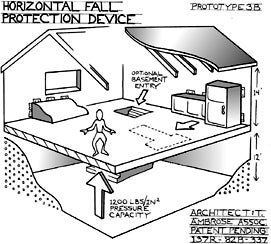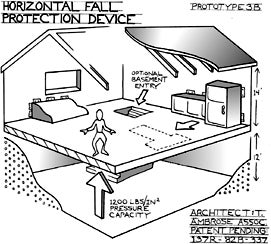An ingenious new device has taken the architectural world by storm, and homeowners are voicing a common cry: “We want Floors!”

The “Floor,” a rigid, horizontal, platform-like device installed seven to ten feet above the basement, permits people to remain suspended above the basement area, rather than plunging straight downward, as was inevitable before.
“In my research, I found that gravity was the number one culprit in basement fallage,” said Floor inventor Theodore Ambrose, an MIT graduate with a doctorate in physics. “Persons with mass, which is virtually everyone, were drawn toward the Earth’s center, and therefore toward their basements, by gravity. My concept places an object between the individual and the basement, keeping them a fixed distance apart.”
In the past, persons entering their homes plummeted straight to the basement, unable to reach the living areas of their house. Moving any belongings indoors was similarly problematic. “All our stuff used to end up in a heap in the basement,” Floor owner Gail Holloway said. “Our lives were very much basement-oriented.”
“I based my design on the horizontal nature of the bottom of the basement,” Ambrose explained. “I wondered, why do things fall to the basement, but no further? After some preliminary diagrams, I was ready to construct my first crude prototype.”
That prototype was a network of ropes stretched across the top of the basement, which homeowners could walk across to reach other areas of the house.
“It worked moderately well, but some people, particularly the elderly, could not keep their balance on the precarious network,” Ambrose said. “Also, their possessions remained in the basement where they could not readily reach them.”
An oversized lazy-susan-type disc that spun rapidly like an amusement park ride came closer still, but as Ambrose observed, “People and things were propelled into the walls, which was not markedly better than the basement situation.”
After several failed tries, Ambrose finally hit upon inspiration. “Desperate, I looked up to the ceiling. The ceiling, and its function, struck me. It keeps the shingles on the roof, and motionless as well. I thought, what if the same principle were applied to an area lower in the house? What if there was some sort of basement ceiling?”
Four years later, the Floor was born. When Ambrose introduced his concept at a trade show, construction firms were skeptical at first, thinking it a novelty upon which consumers would not want to spend hundreds of dollars. Only after one of Ambrose’s satisfied neighbors put up his own money, Floor Industries was established on a $30,000 mortgage. Today, thousands of homes have had floors installed, and the orders keep coming.
The business world has caught on to the concept as well, with the Sears Tower in Chicago adding hundreds of high-tech Floors.
“This should make working here much more pleasant,” said Sears Tower official Hal Gabriel. “Until now, the interior of the skyscraper was a jumbled mass of equipment and moaning bodies piled up to the eighth floor. Very little work was possible under these circumstances. Now, everyone who works in the building will be able to access an assigned Floor, around which their work will be centered. The building’s mortality rate should decrease to virtually zero.”
Ambrose warns consumers of counterfeit Floors being produced in the Far East. Often made of shoddy materials like balsa wood or plastic foam, these knock-offs are not only illegal, but also dangerous. Safety experts caution that extreme weight can punch holes in these cheaper surfaces, which makes the Floor less effective against gravity.
So what is the self-made millionaire working on now? “I’m tinkering with the idea of some sort of button you can push that will make appliances go on,” Ambrose said. “I’ve noticed appliances are not useful, and I’d like to do something about that.”







